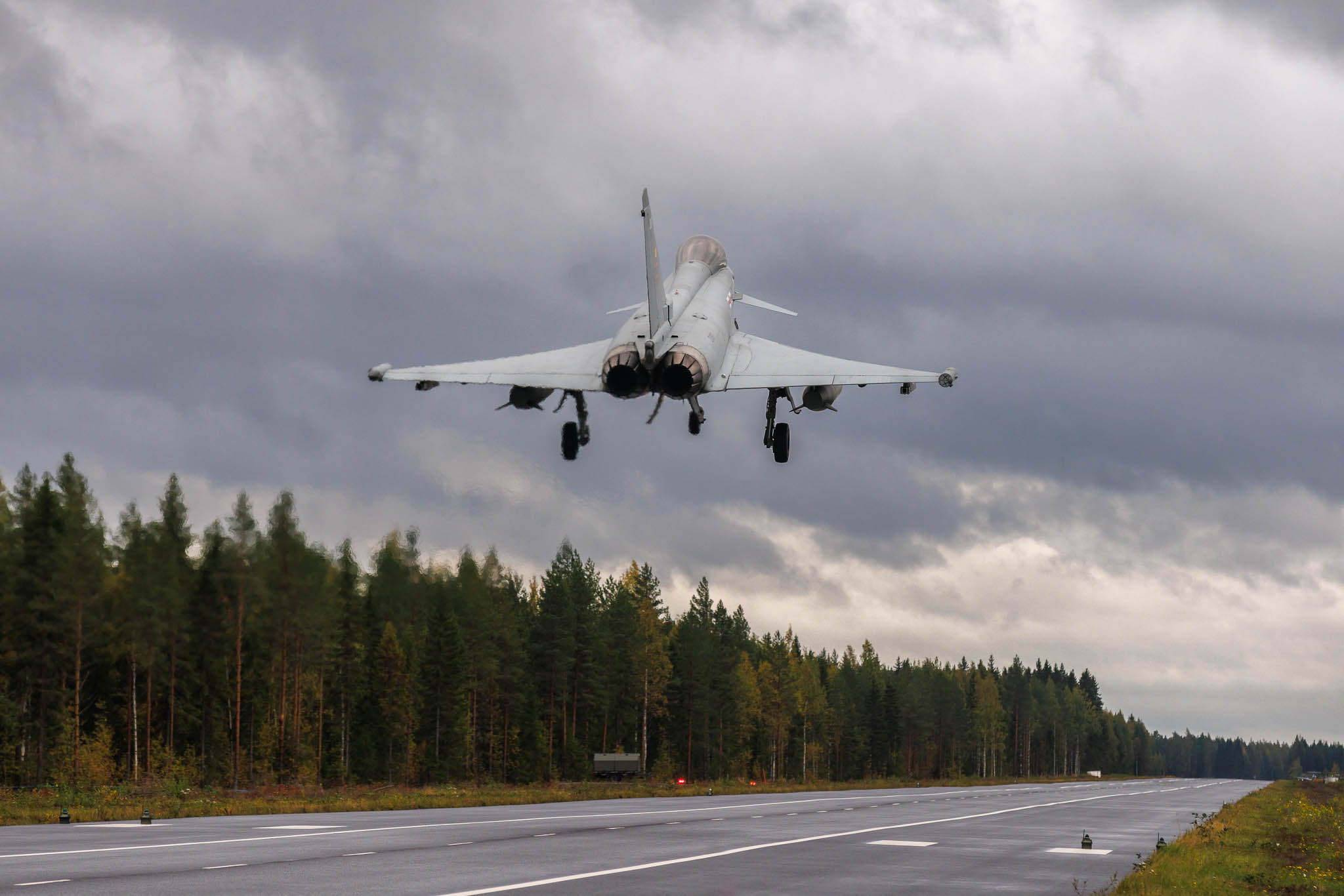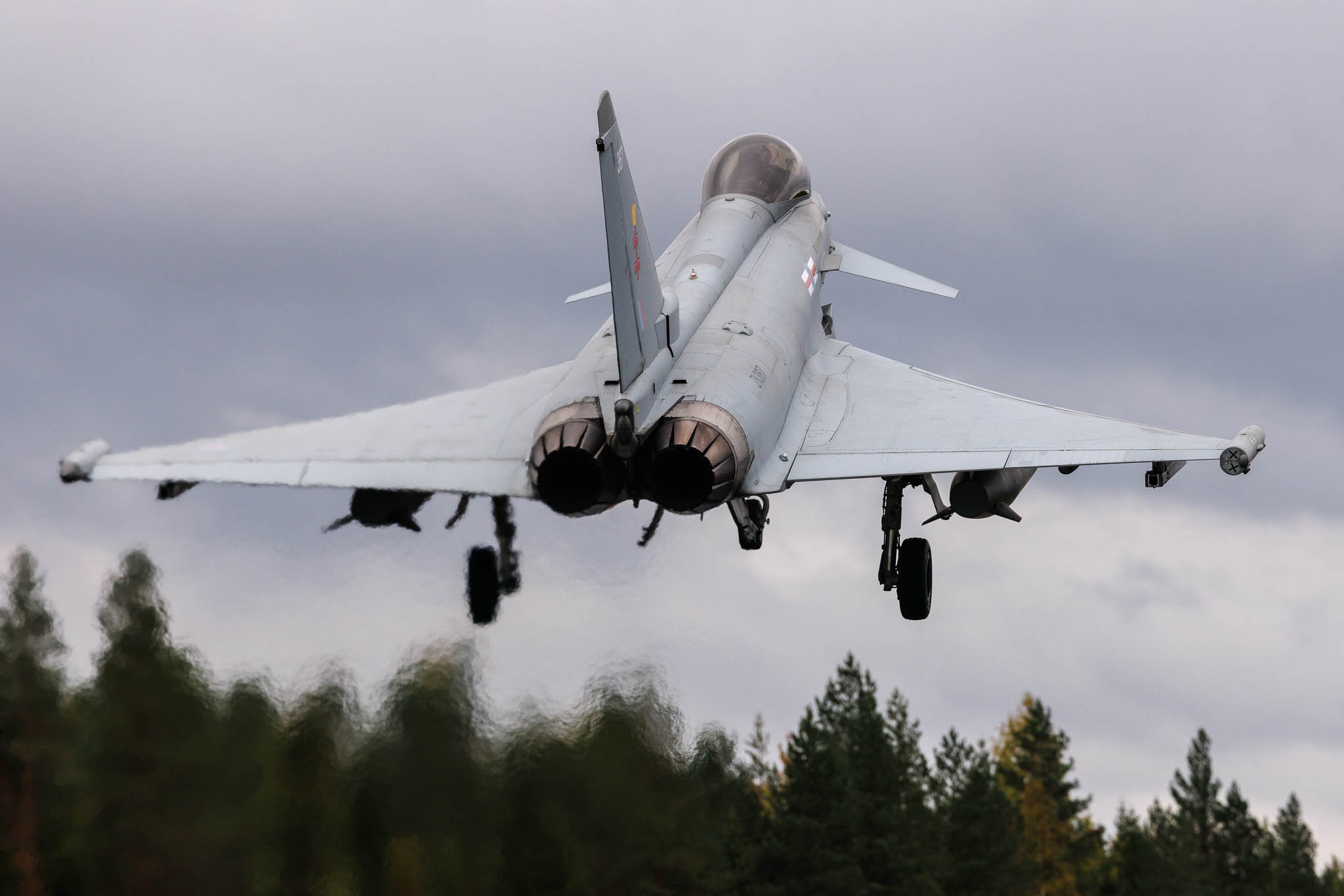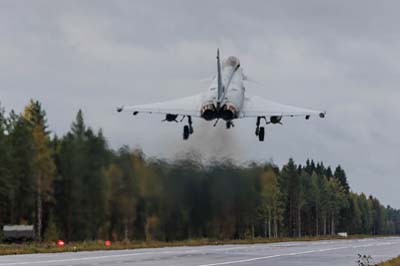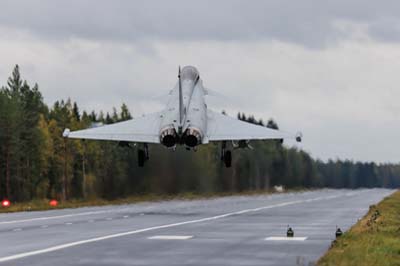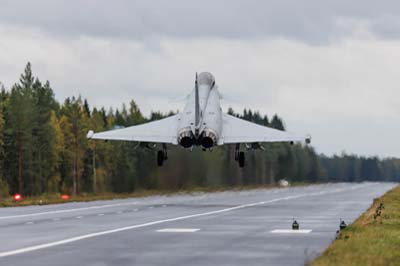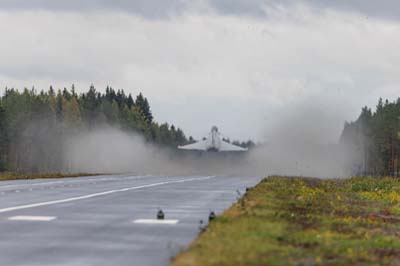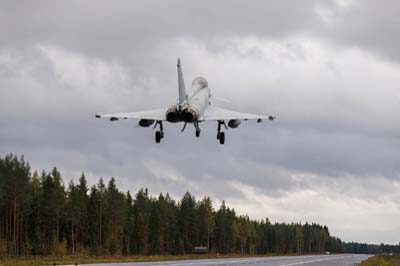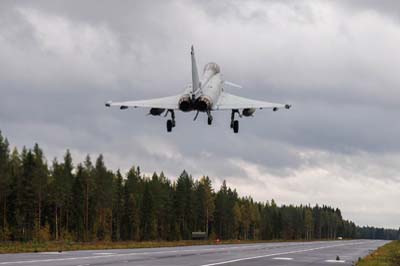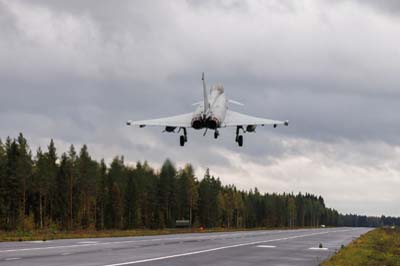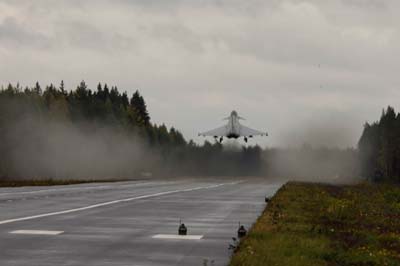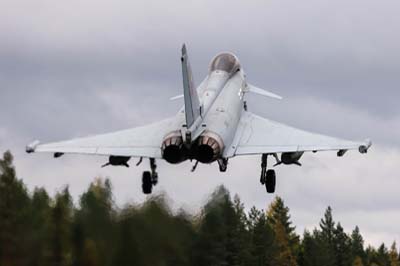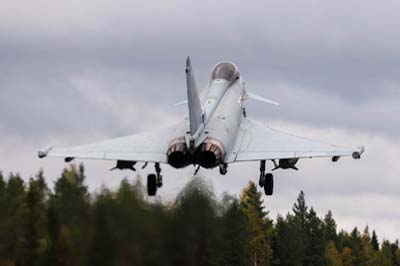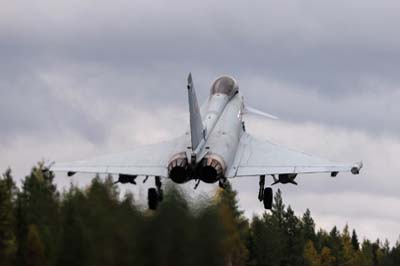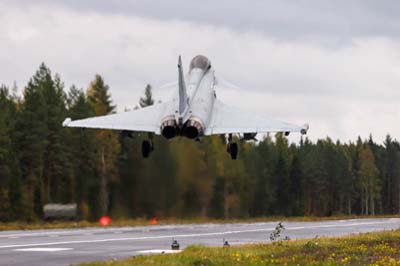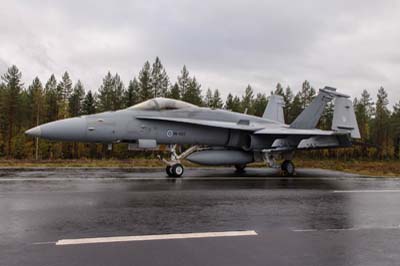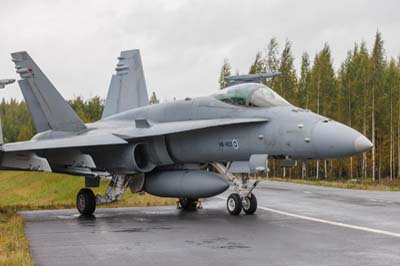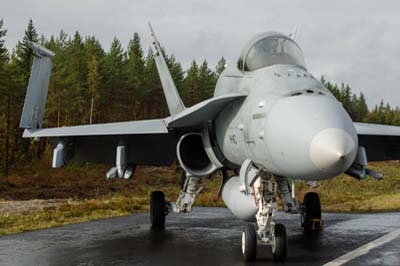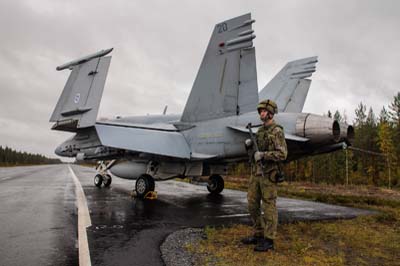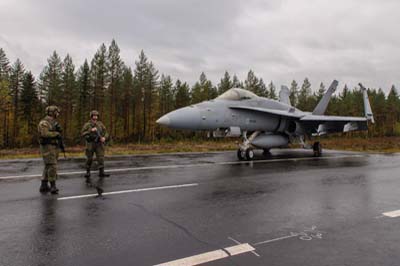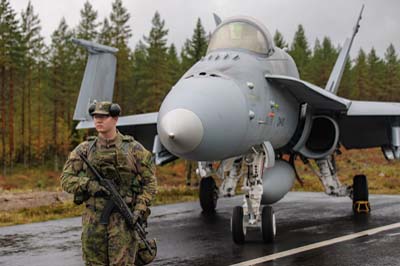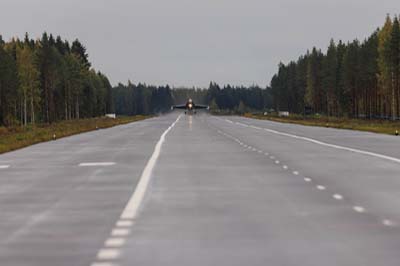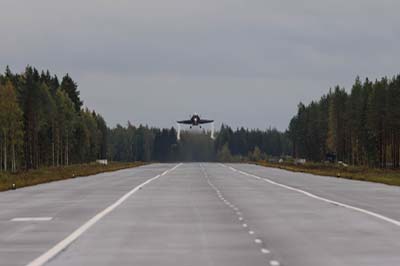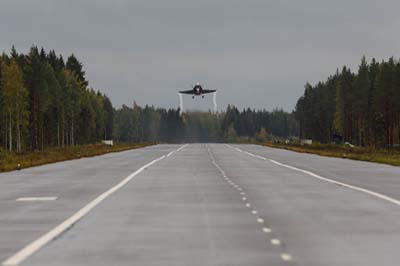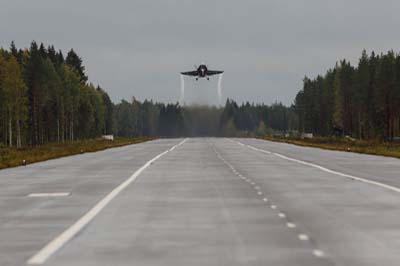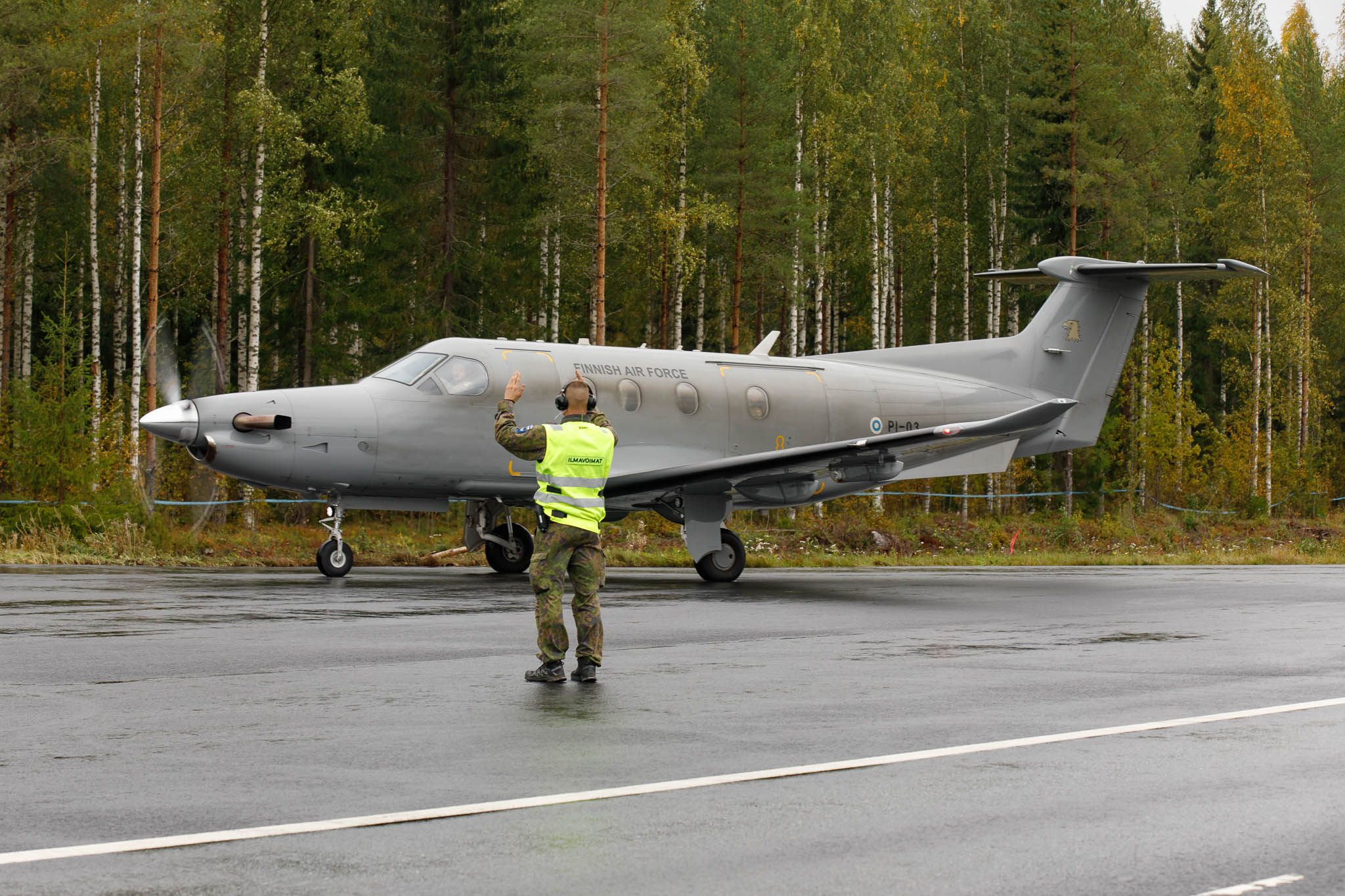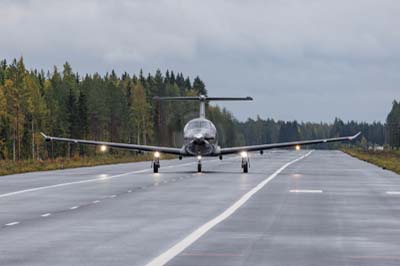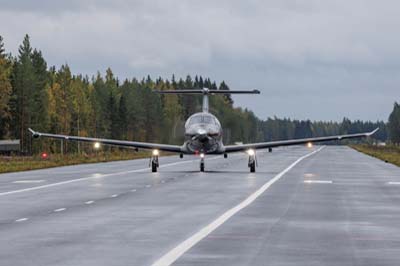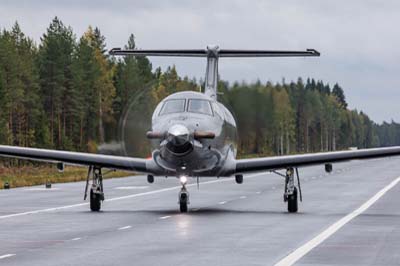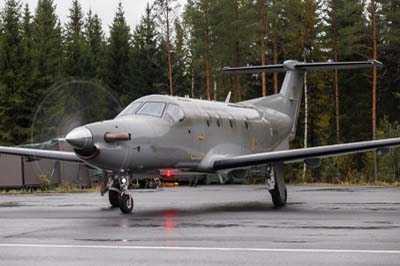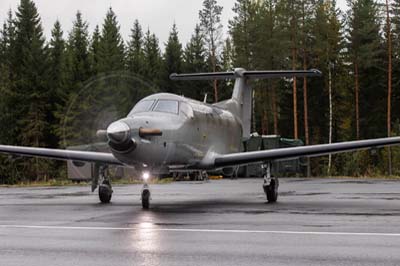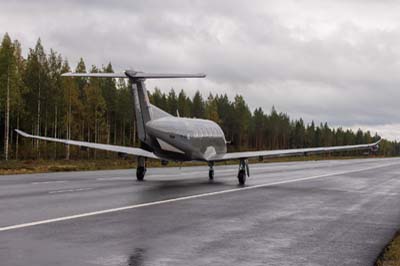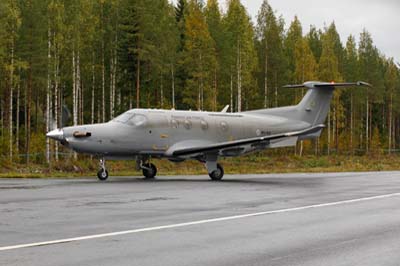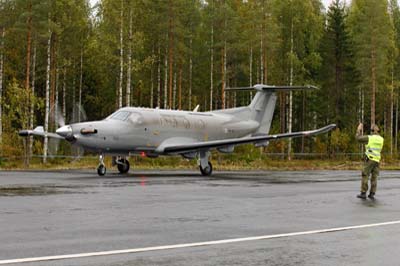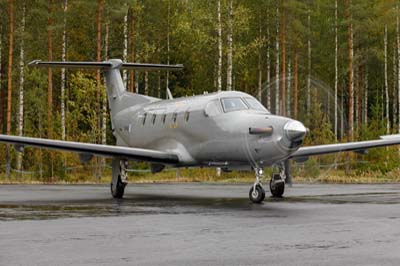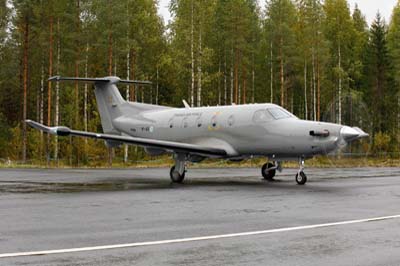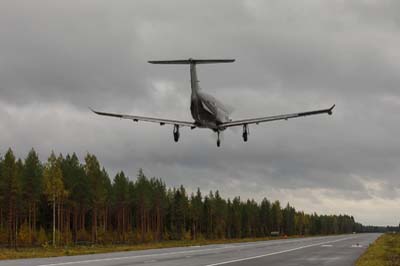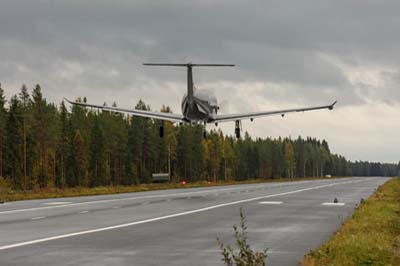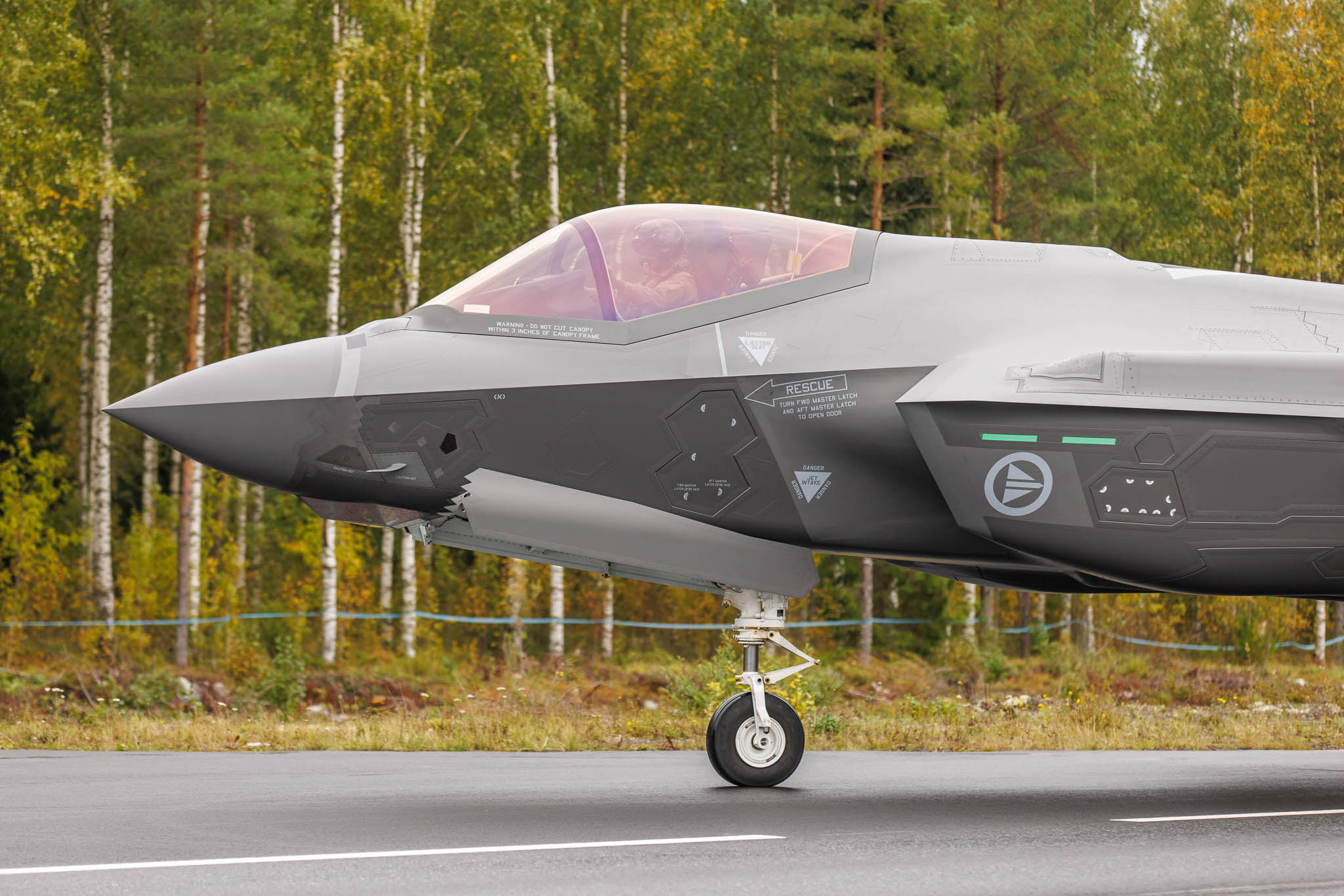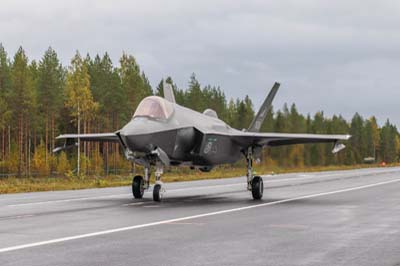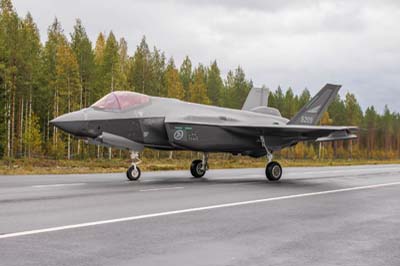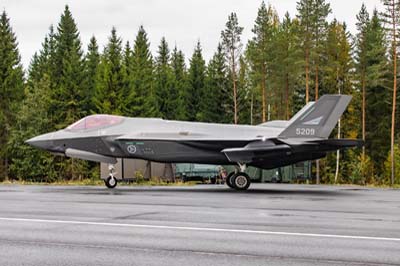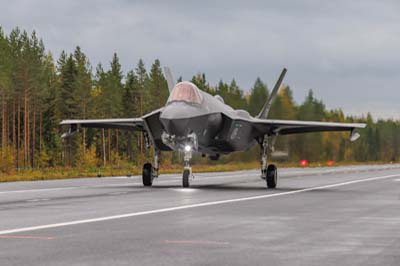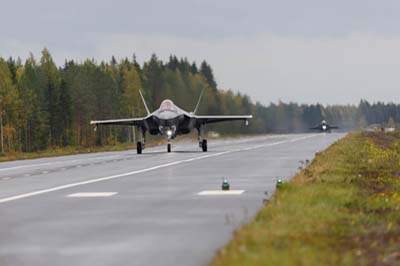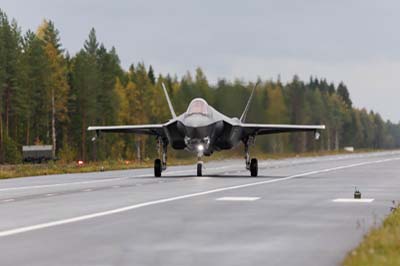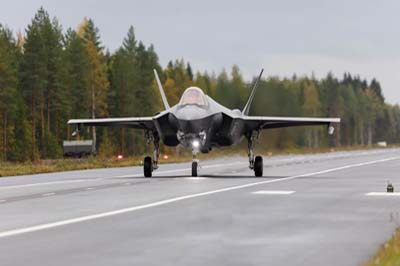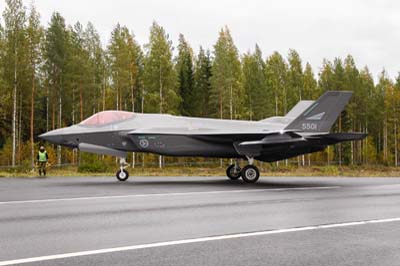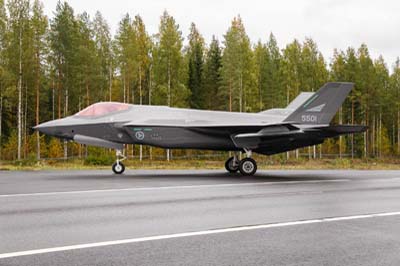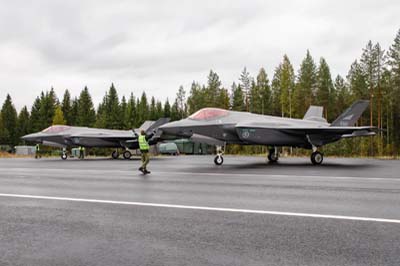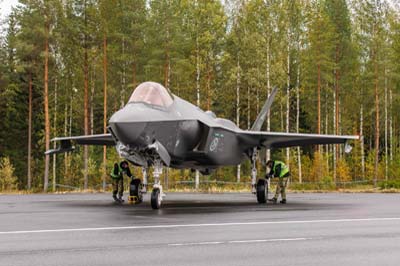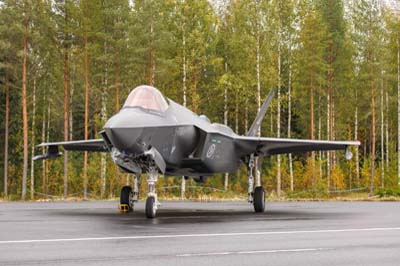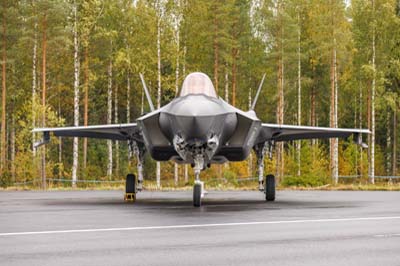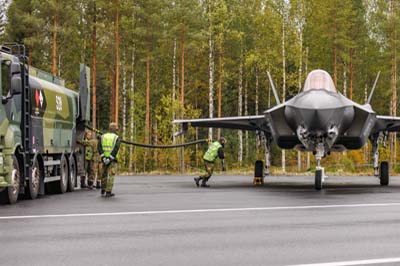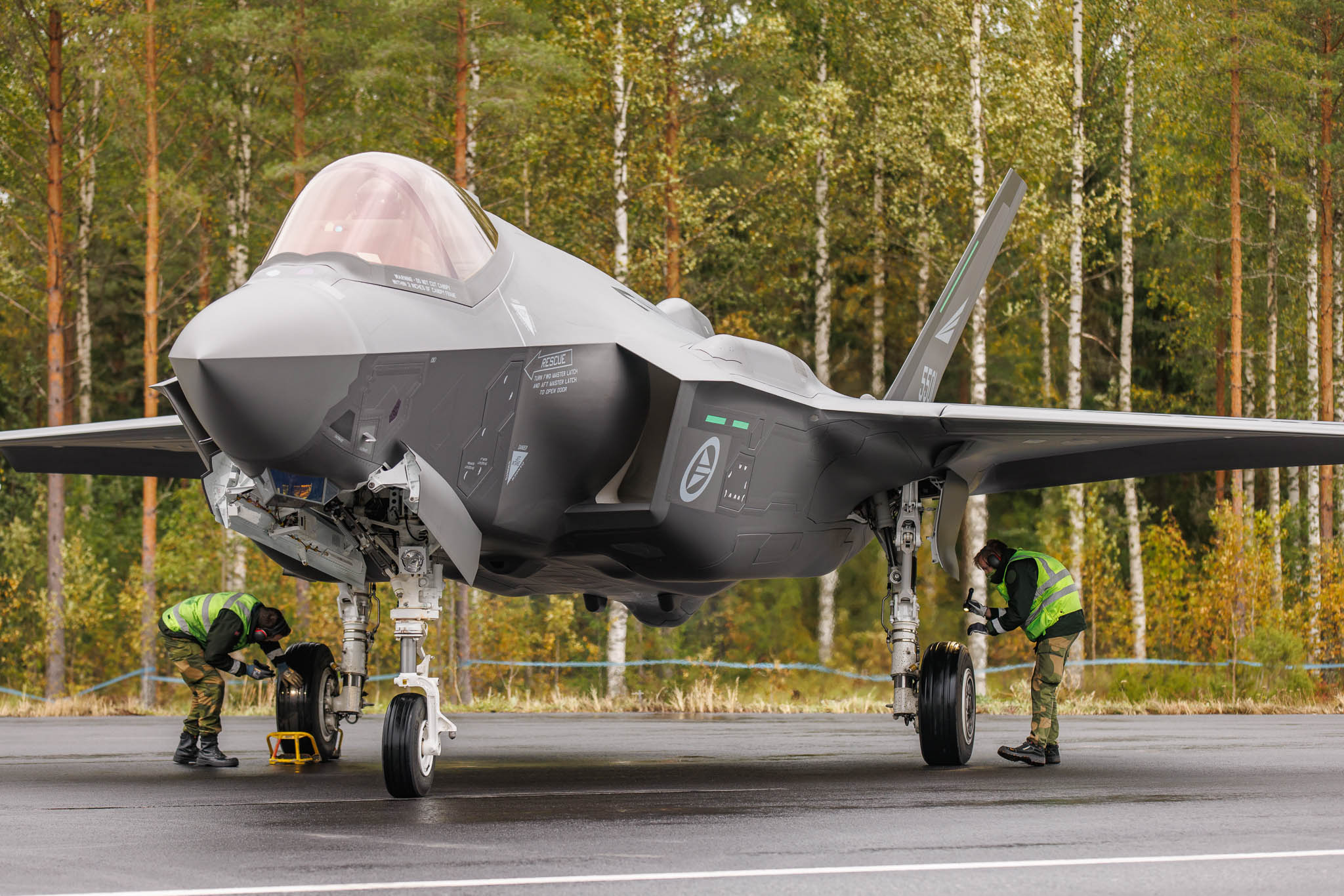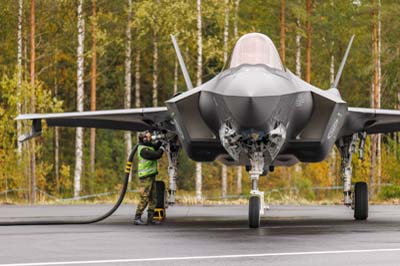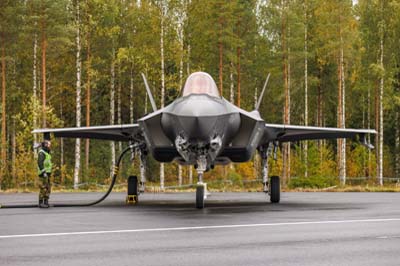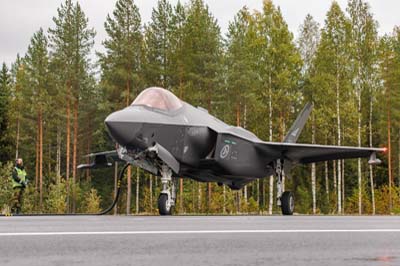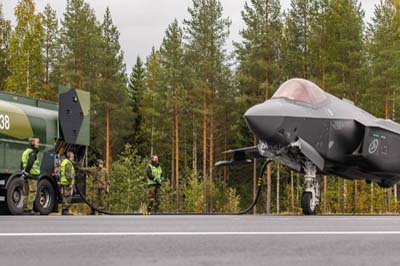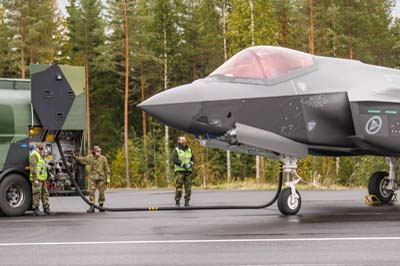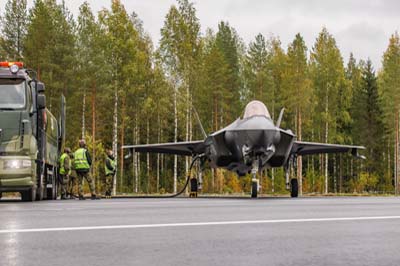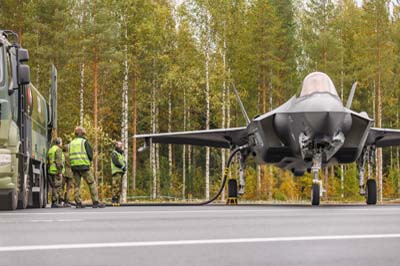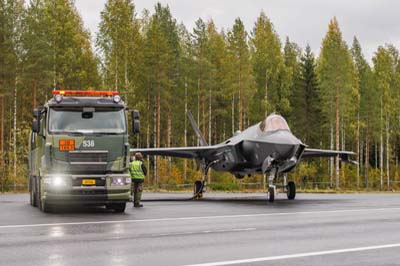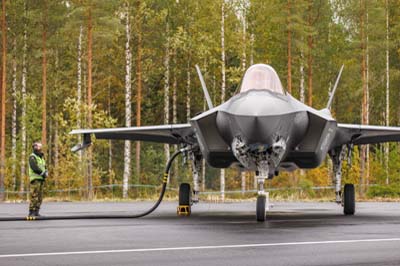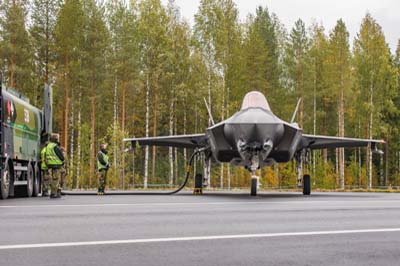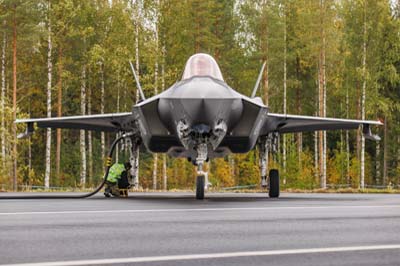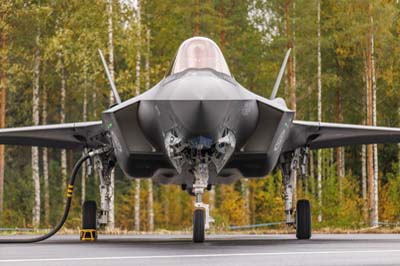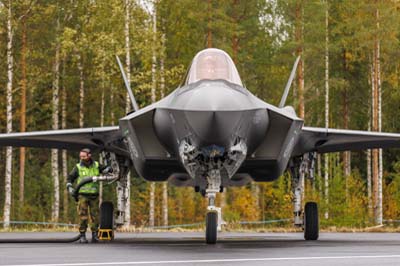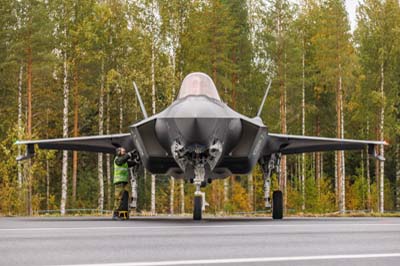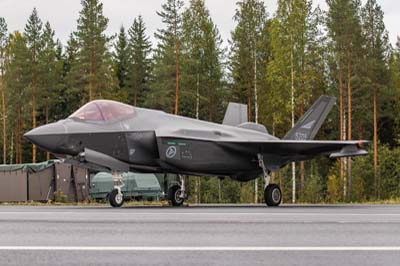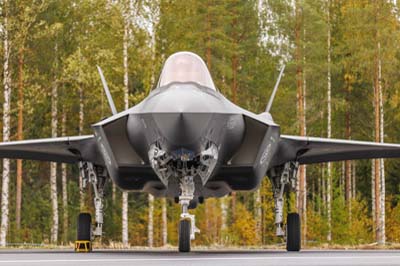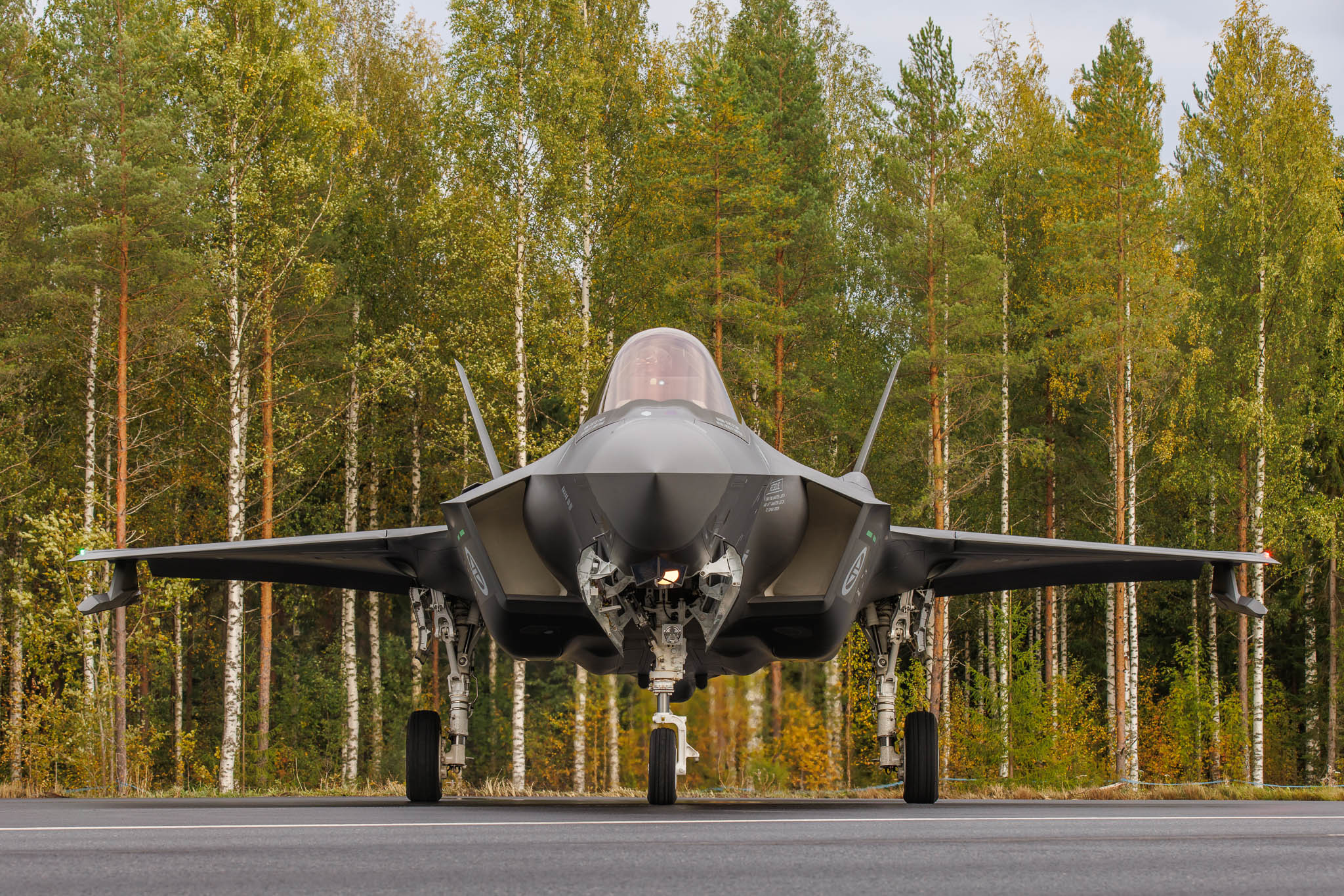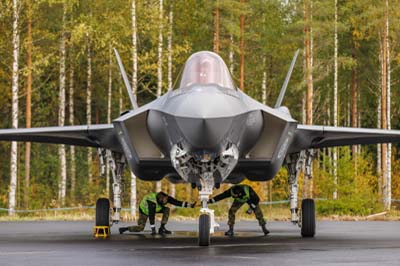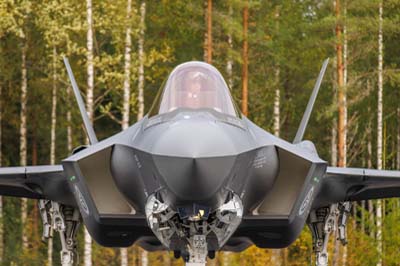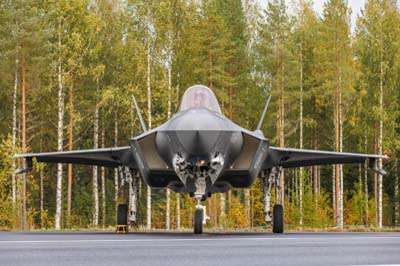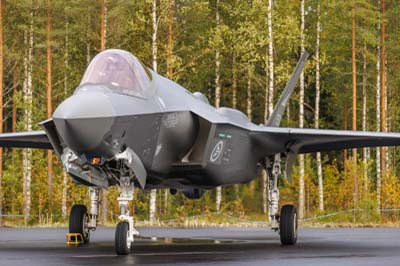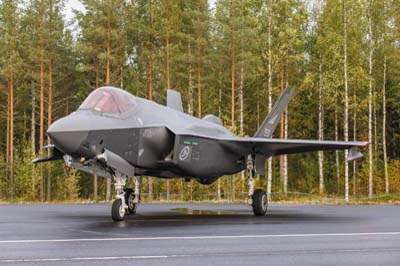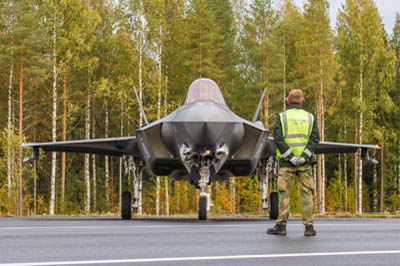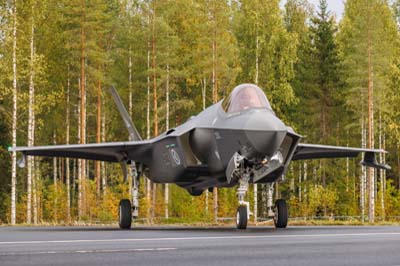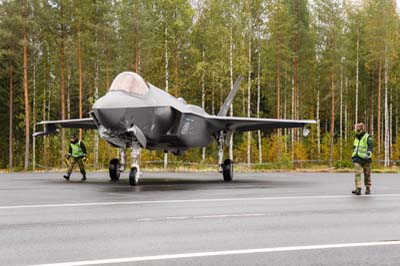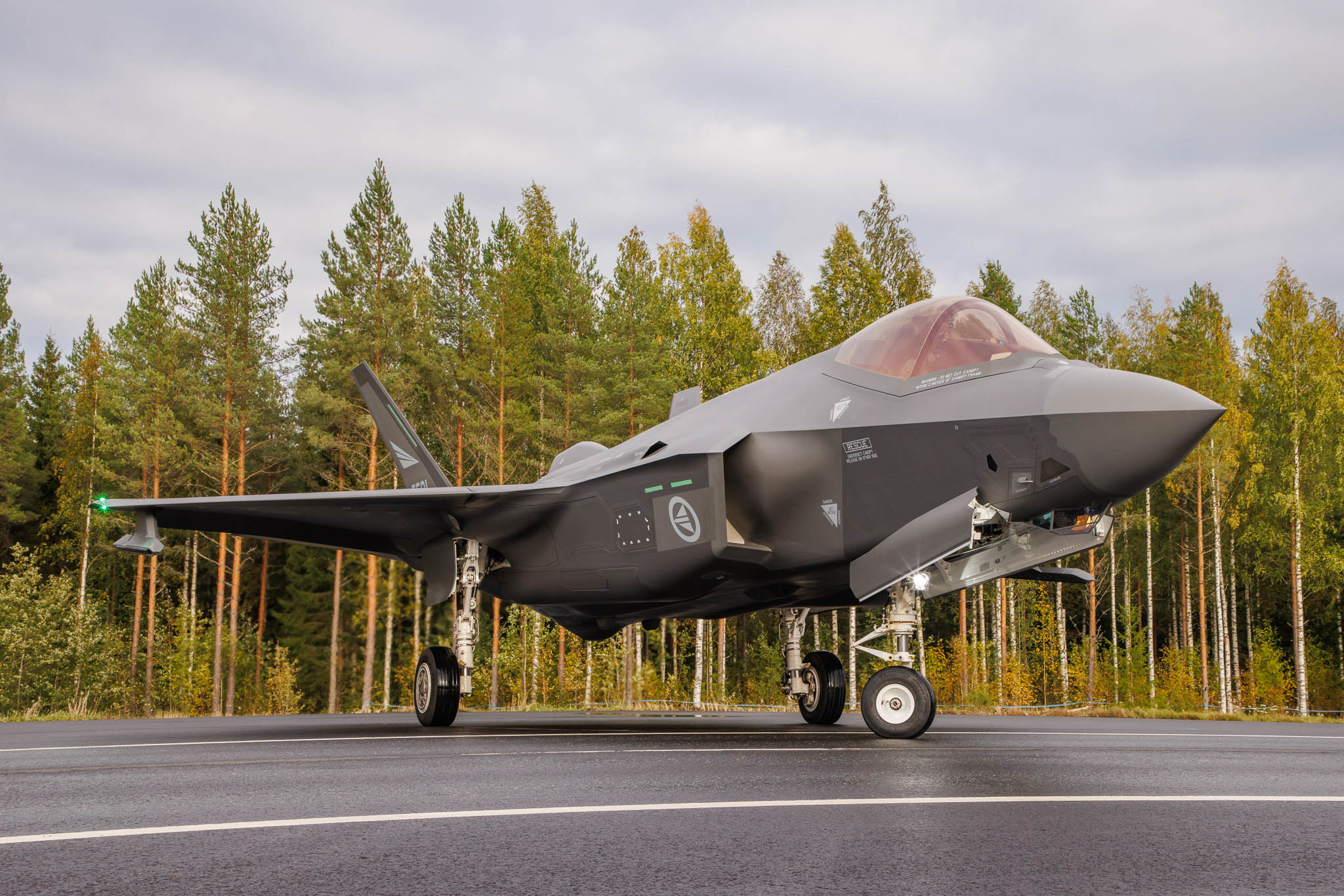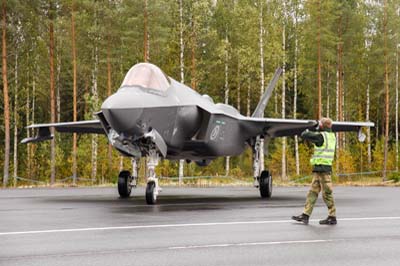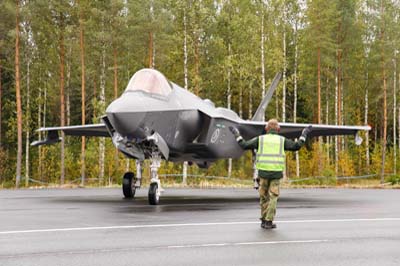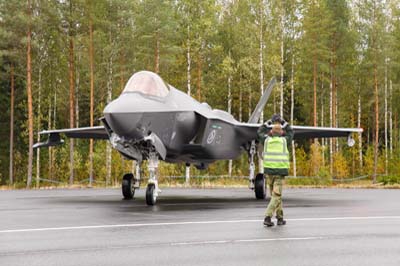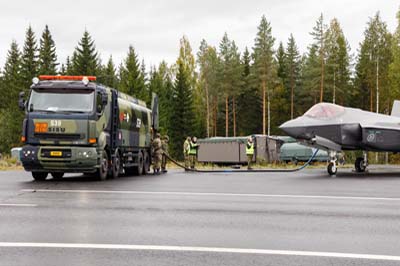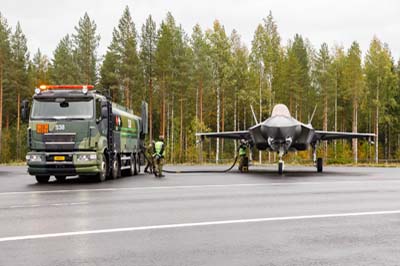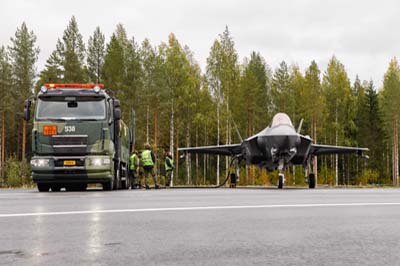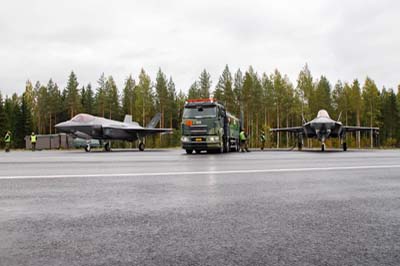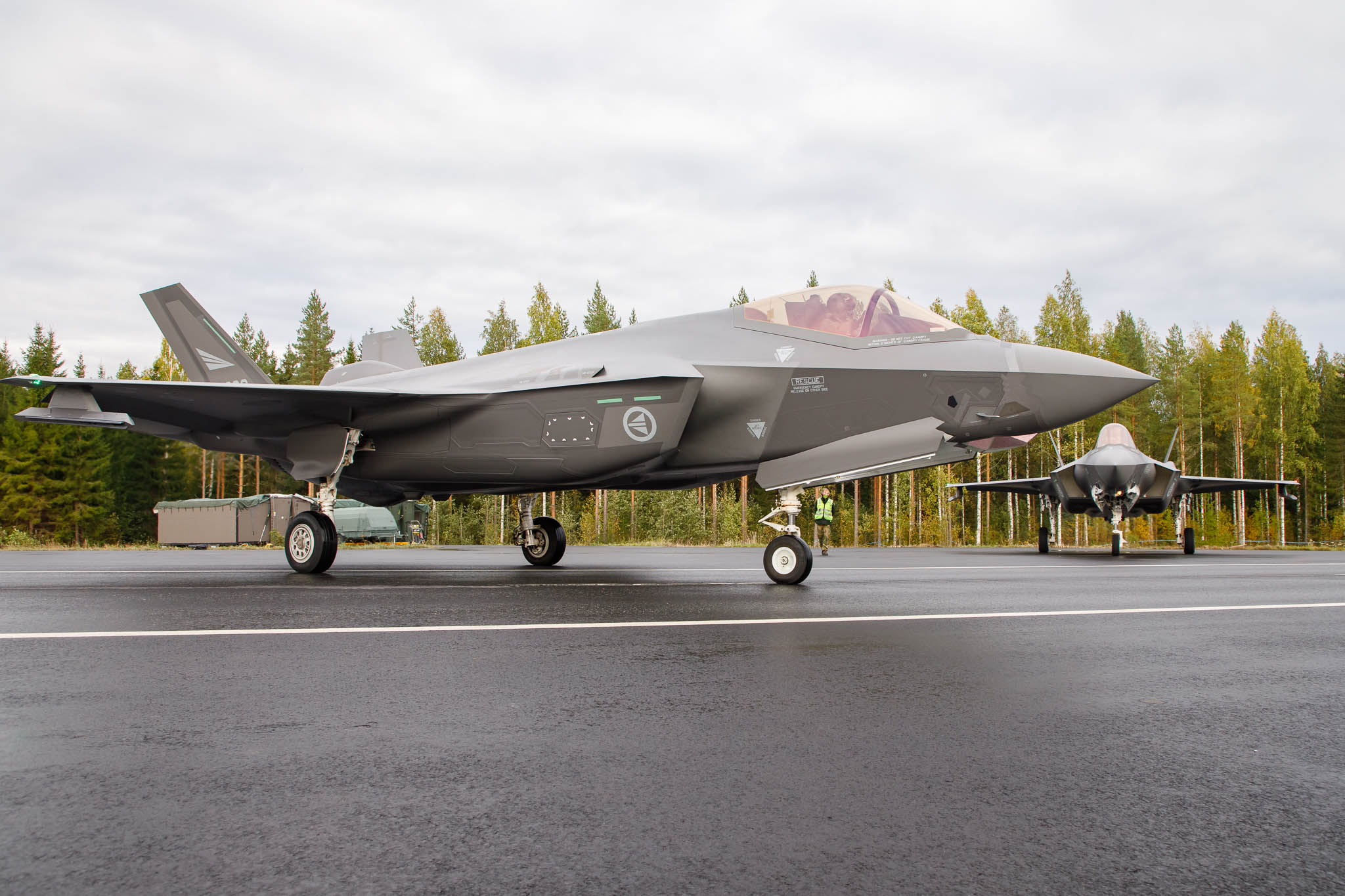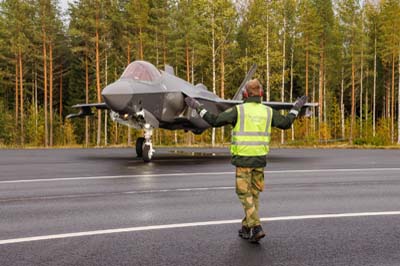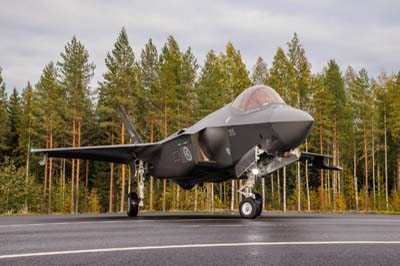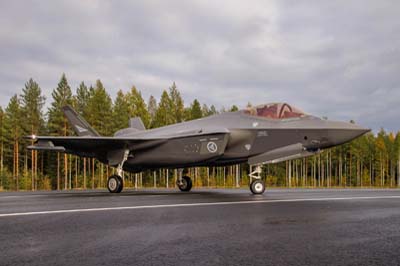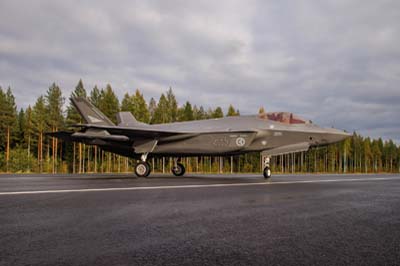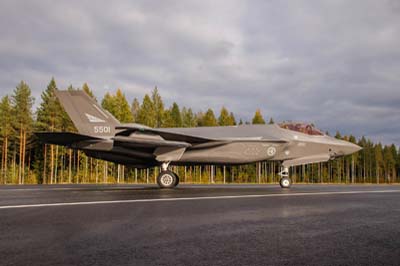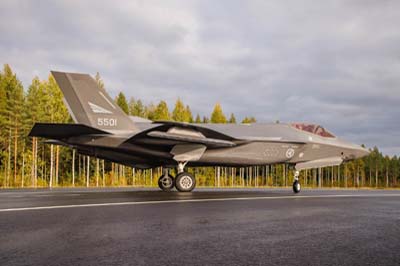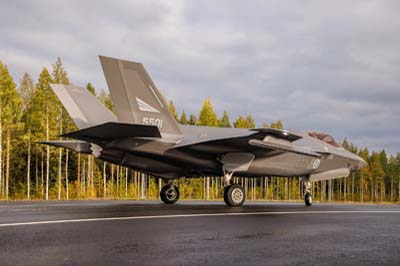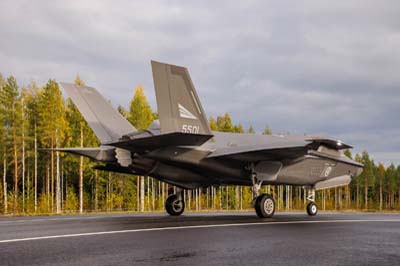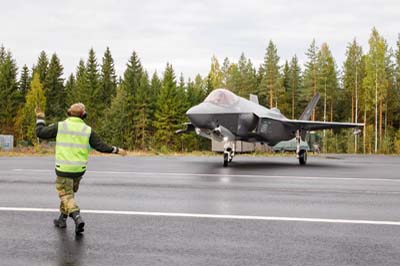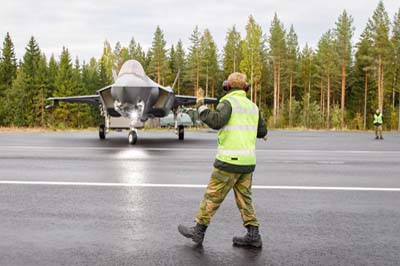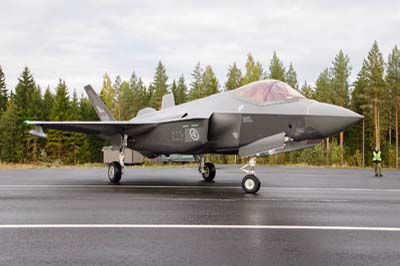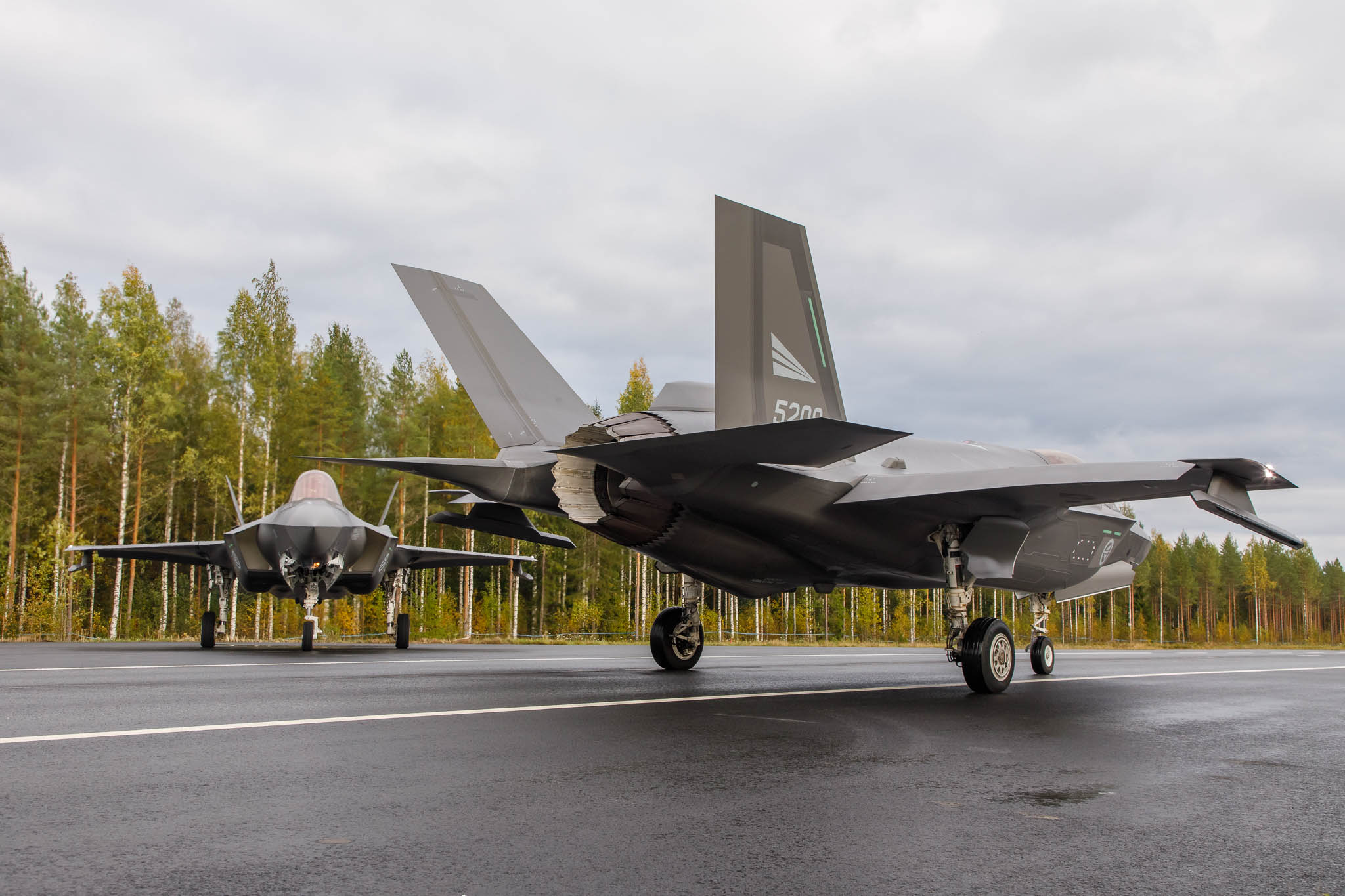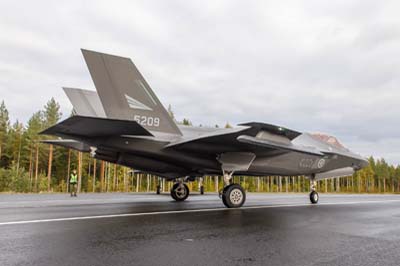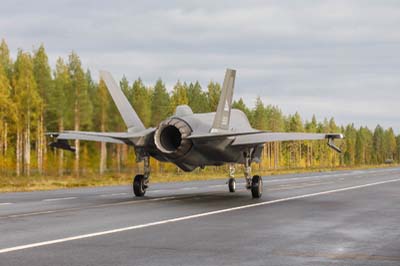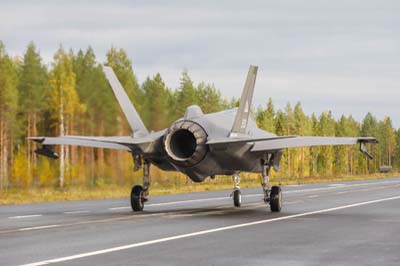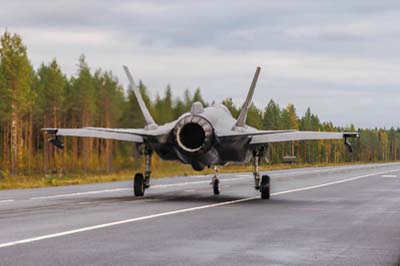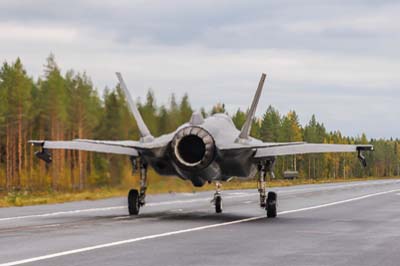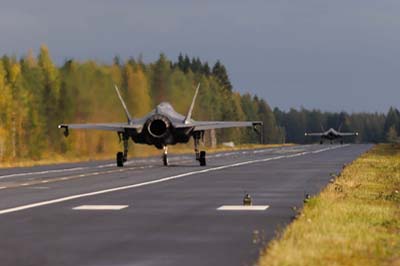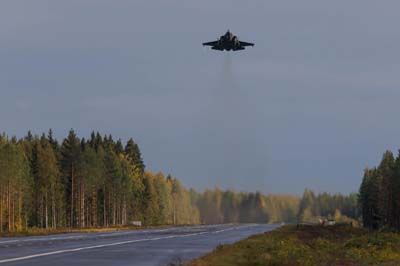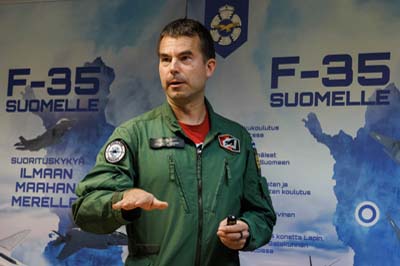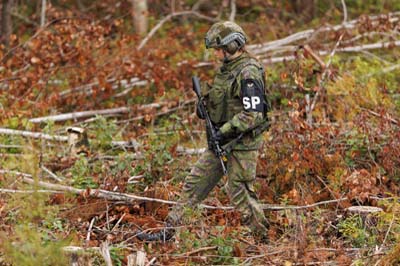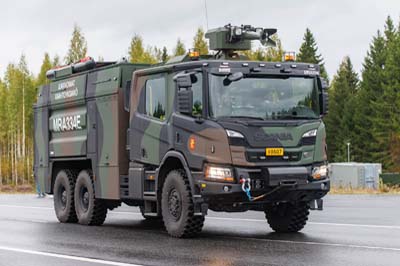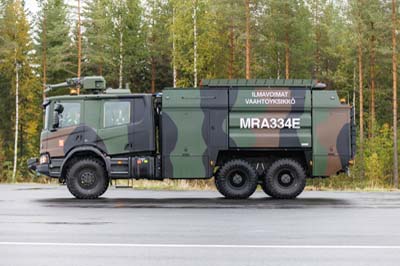Low-Level Flying Photography
Exercise Baana 23
Tervo, Finland
September 21, 2023
|
Eurofighter Typhoon FGR.4 (ZK367 '367') with 41 Test and Evaluation Squadron. The Officer Commanding of 41(TES) was one of the two pilots to take part, he said: "This is an opportunity to work with one of our newest NATO partners on an exercise in Agile Combat Employment. The Finnish have worked hard for decades on disparate operations should they be attacked and need to disperse their aircraft."
|
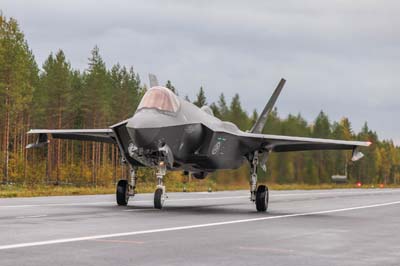 |
The first landing of an F-35A on a road. |
Baana is the Finnish Air Forces annual dispersed operations exercise, this year was held near Tervo, in the province of Eastern Finland. As Finland joined NATO on April 4, 2023, just weeks before Baana 23 and the Royal Air Force (RAF) were quick to request the opportunity to use a highway strip for the first time, flying the Eurofighter Typhoon FGR.4. They were joined by another NATO member, the Royal Norwegian Air Forces (RNoAF) attended with their Lockheed Martin F-35A Lightning IIs also for the first time.
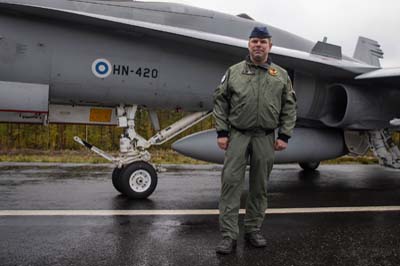 |
Karelia Air Command Commander, Colonel Johan Anttila. |
Road landings are becoming more relevant
Finland has many dispersed landing strips for its air force, exactly how many is classified. Estimates would put the number at around thirty. They form part of the highway network, in use everyday by road traffic. Each one is used perhaps only once or twice every 50 years, last year's Baana 22 was held on a highway strip that had not been used since 1978. The Finnish Air Force has been utilising roads for dispersed landing operations from around World War Two and before then, they used fields and frozen lakes, as many of their early propeller powered aircraft were fitted with skies. The capability to operate from remote and semi-prepared fields continued with the arrival of the de Havilland Vampire, the Finish Air Force's first jet powered fighter, delivered in 1953. It was not until the 1960s did Finland start fully preparing designated highway landing strips, the Government to gain public acceptance, described them as emergency landing strips for civilian airliners.
Most people may not even be aware what they are. However, there are signs that you might be driving along one of these highway runways. They are straight and wider than most of the roads in the area, on motorways the central reservation has painted chevrons rather than a fixed barrier. The biggest giveaway is the turning circle perhaps with revetments at each end of the runway.
In times of crisis a country's air force is a vital form of defence. An enemy would certainly target the military airfields, in particular their runways, rendering an air force ineffective. By dispersing military jets around the country at many disguised locations maintains their defensive and offensive capabilities. Finland has an 850 mile (1,360 km) border with Russia, following the devastation inflicted by Russia on Ukraine with precision guided missiles, the requirement to use highway landing strips has become even more imperative.
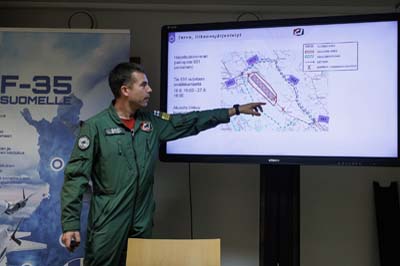 |
Baana 23 Exercise Director Lieutenant Colonel Rami Lindstrom, an F/A-18 Hornet pilot with HävLLv 31 (31 Fighter Squadron) has accumulated 1,000 hours on the Hornet. |
Air Force Command Finland (AFCOMFIN) based at Jyväskylä-Tikkakoski, is the command headquarters of the Commander of the Air Force, and in that capacity is responsible for the direction of Finland's air defence under normal conditions and during times of crises. For Baana 23, Karelia Air Command was the unit given overall responsibility of running this years exercise. The Karelia Air Command Commander, Colonel Johan Anttila, a Pilatus PC-12 pilot, stated during the event; "Road landings are becoming more relevant today. For operations in Afghanistan and Syria road landings were not a priority, but now with the conflict in Ukraine it has become very relevant. Conventional air bases can be destroyed with cruise missiles but dispersed aircraft in 30 road bases need 30 times more missiles to take out all the aircraft that can be found."
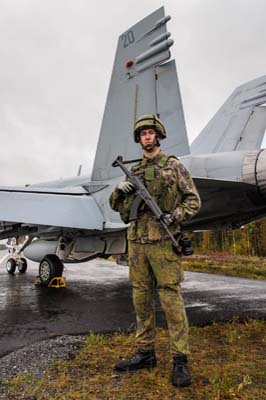 |
Using Finnish military conscripts and reservists. |
Pilots are required to practice operating from the highway landing strips periodically to maintain this valuable capability. The Baana exercise is run each year, enabling new pilots to gain road operations skills and experienced pilots to re-qualify. Typically 30-minute flying blocks are assigned to a pair of Finnish Air Force Boeing F/A-18C/D Hornets. Both aircraft fly visual circuits with five or six touch-and-goes both day and night before pilot qualification is awarded. The two-seat D variant is crewed with an instructor and pilot new to such operations. Each exercise aims to re-qualify 40 to 50 pilots and qualify 15 new pilots for highway operations. The Bae Hawk Mk.51/66 is also routinely used to enable Hawk instructors to also re-qualify.
Col Lindstrom described his personal experiences of road operations and the landing procedures: "My first road landing was in 2002 flying the Hawk. It was challenging, especially when I did it for the first time at night, perhaps a little scary. Having done it once then it becomes easy. It looks like a normal runway but they are 60 meters wide this is only 25 meters wide. It's in the middle of nowhere in a forest and is difficult to find without good navigation. Using VFR [visual flight rules] you are looking out the cockpit all the time."
It's no easy landing
The highway strips are perhaps a little more than a third of the width of their air base runways and appear incredibly narrow to the pilot when they make their first approaches. Pilots will start with daylight touch-and-goes and then landings to hot-pit refuel followed by a swift take-off. Pilots progress to nighttime operations using NVGs (night vision goggles) and small roadway edge lights. Pilots can't expect clear weather for this essential training, they should be proficient in all types of extreme weather. At Baana 23, with a cloud ceiling falling to just 300 feet AGL (above ground level) and 1.2 km of visibility, pilots dropped down to 250 feet by using air traffic controllers at Kuopio/Rissala air base, the nearest military airfield. They then flew at low level using their GPS to find the highway strip near to the town of Tervo. Non precision approaches with RNP (required navigation performance) landings or GPS approaches using GPS points a calculated glide slope is very demanding especially in poor weather.
PAPI (precision approach path indicator) lights are the only aid for the visual landings at night, a temporary air traffic controller container is situated on the edge of the landing road. "We have used tactical ILS [instrument landing system] equipment in the past but it is no longer available, its obsolete but looking for modern tactical ILS equipment." admitted Exercise Commander Col Anttila.
A highway strip can be prepared in less than 24 hours if required. For Baana 23 one year of planning took place. Four months before the event, the Finnish Transport Agency were informed of the location for the exercise. Plans were then put in place for the removal of trees 50 meters from each side of the road for safety reasons and for local traffic diversions and signage. During the exercise, the area is protected from civilian incursion with a large Finnish military presence, enforcing a wide exclusion zone around the highway landing strip and to man check points. |
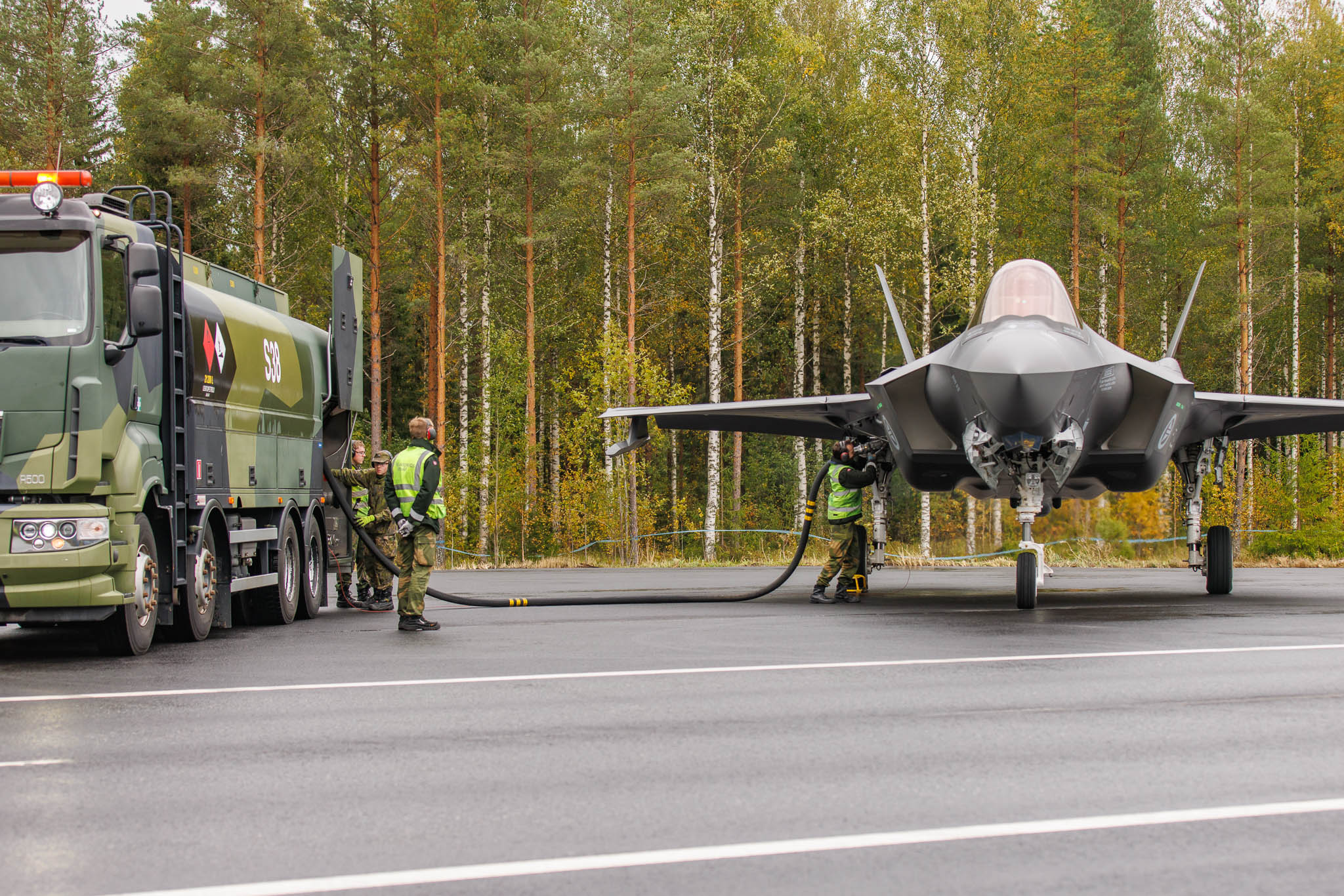 |
Immediately after landing, refuelling was conducted with the engines running, so-called as 'hot-pit refuelling'. Shortly after, the F-35As took off and were ready for new missions.
Norwegian Major General Rolf Folland, Chief of the Air Force, spoke: "The aim of the dispersion concept is to make it more challenging for an enemy to take out our aircraft when they have to be on the ground. If such a concept is to work, we must map out all possibilities, and practice them." |
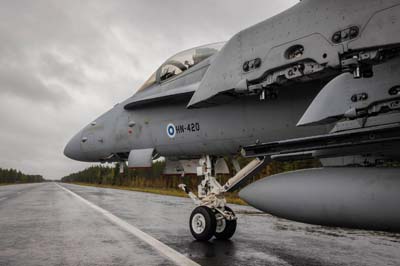 |
F/A-18C/D Hornet (HN-420 '20') pointing down the highway landing strip. |
Finland's new NATO partners
Two 41(TES) Squadron Typhoon FGR.4s were deployed to Rissala air base, it can only be speculated that by using the RAFs Test and Evaluation Squadron they will be assessing the pilot skills training required for these operations, to pass it on to the Ukrainian pilots, currently being trained on the F-16 Fighting Falcon.
Air Marshal Harvey Smyth is reported to have suggested that the RAF is to use dispersed road landing sites in the UK for its F-35B fleet; "The RAF plans to lay down aluminium AM-2 mats along a strip of road up to 1,500 feet long, allowing the F-35B to perform short take offs and vertical landings without damaging the underlying road." The last RAF front line jet to land on a road in the UK was a Jaguar which landed on the soon to be opened M55 motorway in April 1975.
NATO has very rarely used public roads as dispersed landing fields since the end of the Cold War. The appalling devastation swiftly inflicted on Ukraine's military airfields at the start of Putin's 'special military operation' by precision guided missiles, has surely shown that Finland is ahead of the game in this concept of protecting its aircraft fighter force from attack. This year the RAF and the RNoAF participated in the exercise for the first time, I am sure many more NATO air forces will be looking for an invite to attend the next Baana exercise held somewhere in Finland.
|
Ruska 23 Low flying
Baana 23 starts with basic road landings and then progresses to a full scale multi service low flying exercise called Ruska 23 in the second week. Basically the whole of Finland is a low flying area with a few restricted areas such as conurbations and where there has been noise complaints, marked with a red ring on pilot's maps. "We don't have minimum heights but it is normally 150 feet AGL. Using Radio Altimeters (RADALT) we fly as low as we can," said Col Lindstrom. He spoke of his low flying experiences: "Departing your base from a QRA [quick reaction alert] flying at 200 feet you fly as fast as you can. In Finland we are often flying in low visibility, so you have to concentrate to avoid telephone masts and birds. The birds start flying south in September, the meteorologist report every morning during the briefing on bird migration with risk calculations."
|
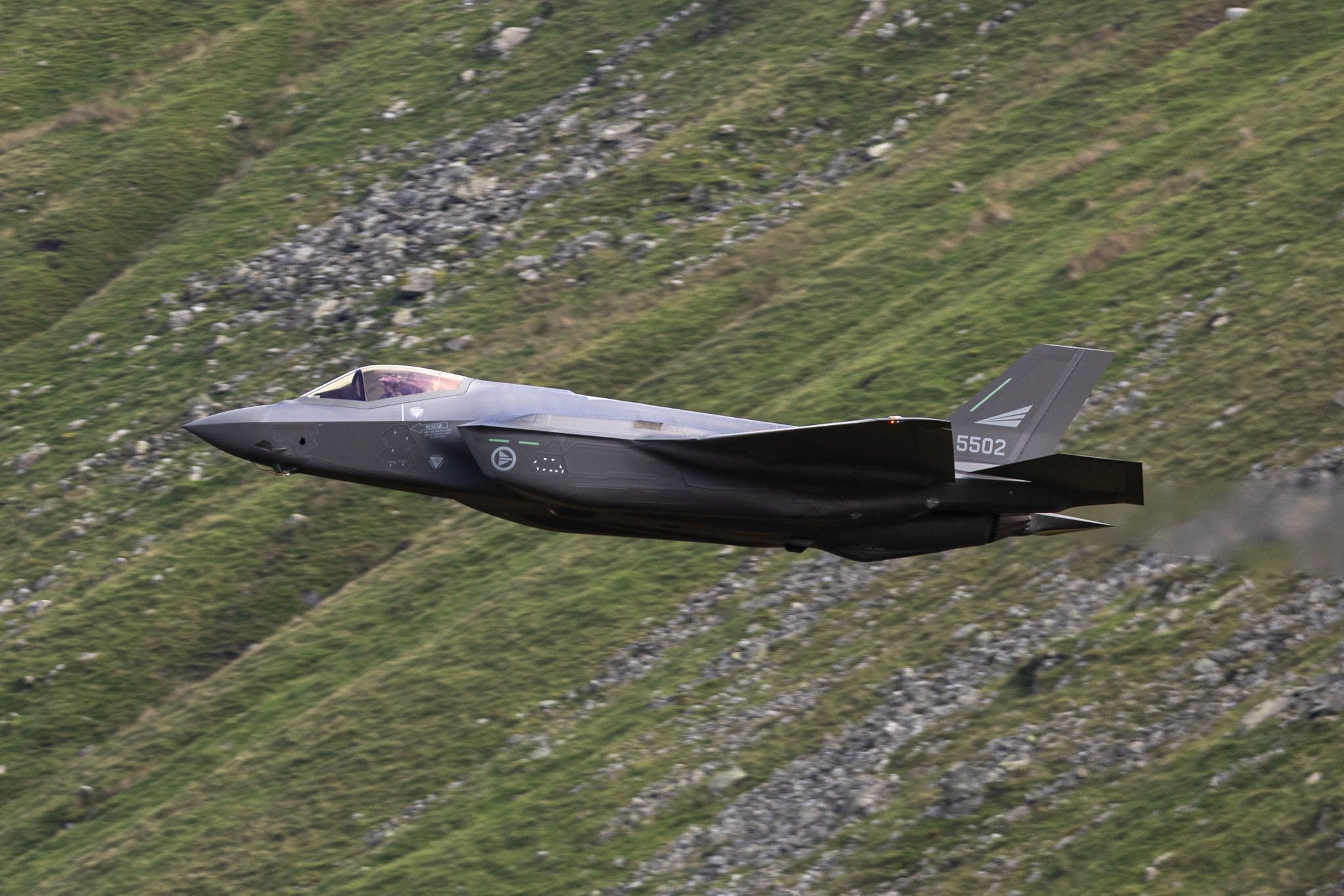 |
F-35A Lightning II (5502) with 332 Skvadron, 132 Luftving based at Ørland.
Cobra Warrior is a RAF hosted multinational live-fly exercise held at the RAF Waddington. Held just a few weeks before Baana 23, this exercise was a good lead into the Finnish exercises for Norwegian F-35s, as it allowed them to practice advanced scenarios and develop tactics, techniques, and procedures in complex situations. Brigadier Tron Strand, chief Norwegian Air Operation Centre (NAOC), said: "Cobra Warrior is a priority exercise for Norwegian F-35s this year. It is a large multinational exercise, together with several allied partners. This gives us and participating units valuable opportunities to practice and develop tactics, techniques, and procedures in complex scenarios." |
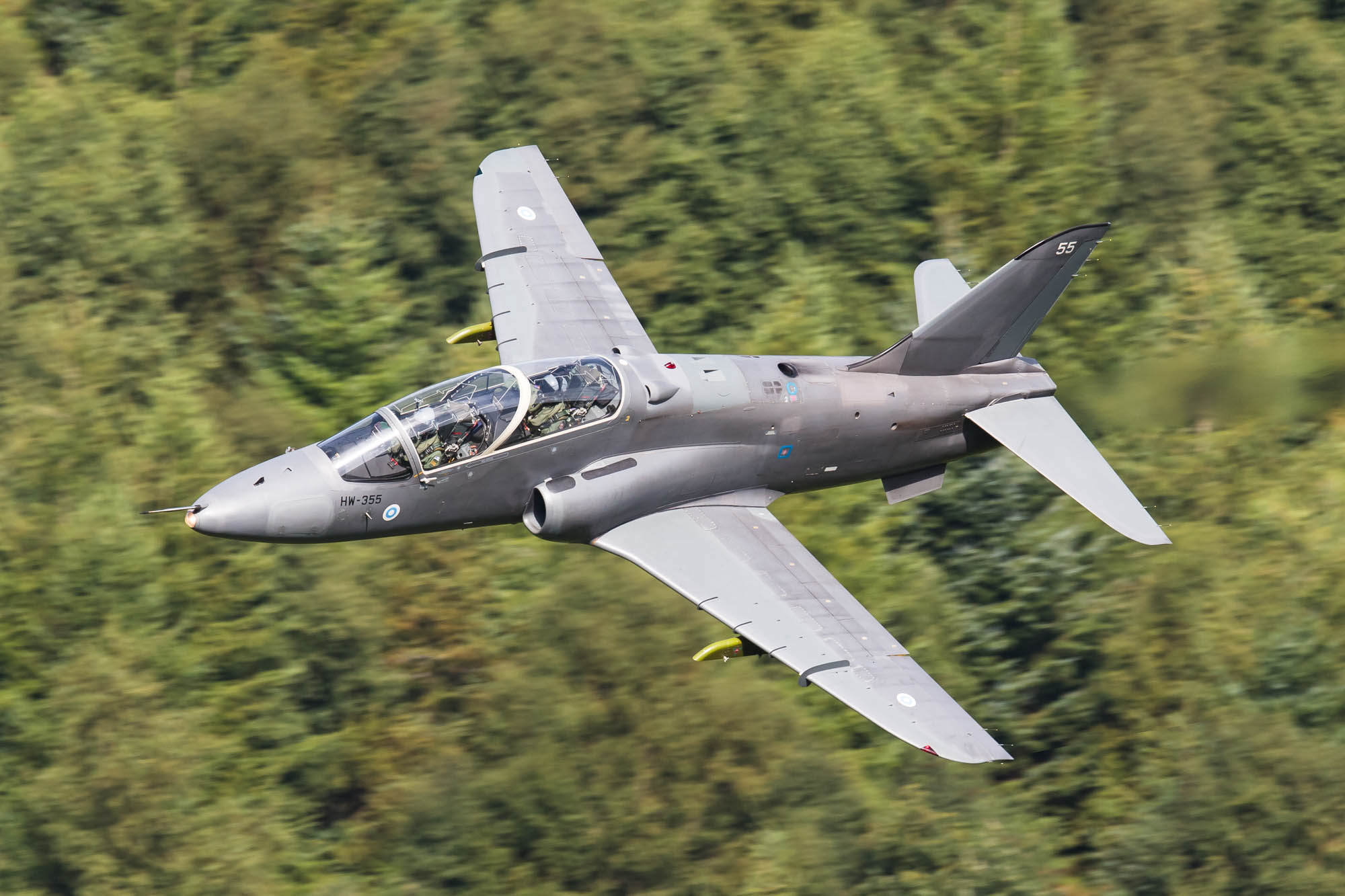 |
Finnish Air Force (Ilmavoimat) Hawk T.51A (HW-355) with HävLLv 41 Training Air Wing based at Jyväskylä-Tikkakoski. In September 2013 the Finnish Air Force Hawks deployed the RAF Valley for a week of joint flying training, with frequent flights at low level.
Col Lindstrom recalls his low flying training on the Hawk: "In the Hawks we flew roughly at the same minimum heights. The main difference was that we did not have RADALT. I remember one time flying the Hawks there was a close call flying low over a frozen lake and everything was white making it very difficult to judge the height and we flew too low which was dangerous." Adding: "It's the rumble or aircraft vibration which you remember with out the speed gauge, whether you fly a 300 knots or 500 knots the sounds are different which tells you if you are flying fast." |
| The RAF Typhoons were back at RAF Coningsby at the end of the first week, not attending the low flying Ruska exercise, their job was done. |
| Left to right: Finnish Air Force Boeing F/A-18C/D Hornet (HN-420 '20') was flown in by Baana 23 Exercise Director Lieutenant Colonel Rami Lindstrom, an F/A-18 Hornet pilot with HävLLv 31 (31 Fighter Squadron). It was guarded by Finnish military personnel. |
| Left to right: F/A-18C/D Hornet performing touch and goes. |
| A Finnish Air Force Pilatus PC-12NG supports the exercise by flying in high ranking observers. |
| Left to right: Pilatus PC-12NG (PI-03) with TukiLLv / 4 Flight based at Tampere/Pirkkala. |
| Left to right: Lockheed Martin F-35A Lightning IIs (5209 and 5501) with 331/332 Skvadron, 132 Luftving, Royal Norwegian Air Force based at Ørland. |
| The Norwegian Lockheed Martin F-35A Lightning II rolls out down on a highway in Finland for the first ever time for any F-35A. |
| The tyres and brake temperatures are checked by Norwegian ground crew soon after the F-35A Lightning II has touched down on the highway. |
| Left to right: F-35A Lightning IIs (5209 and 5501) with 331/332 Skvadron, 132 Luftving, Royal Norwegian Air Force. |
Left to right: Karelia Air Command Commander, Colonel Johan Anttila.
Baana 23 Exercise Director Lieutenant Colonel Rami Lindstrom, an F/A-18 Hornet pilot with HävLLv 31 (31 Fighter Squadron) presenting the landing strip and security zone around it. |
Left to right: Finnish Security Police dispersed around the landing strip, disappearing into the surrounding undergrowth.
Ilmavoimat Vaahtoyksikko (Air Force Foam Unit) MRA334E |
